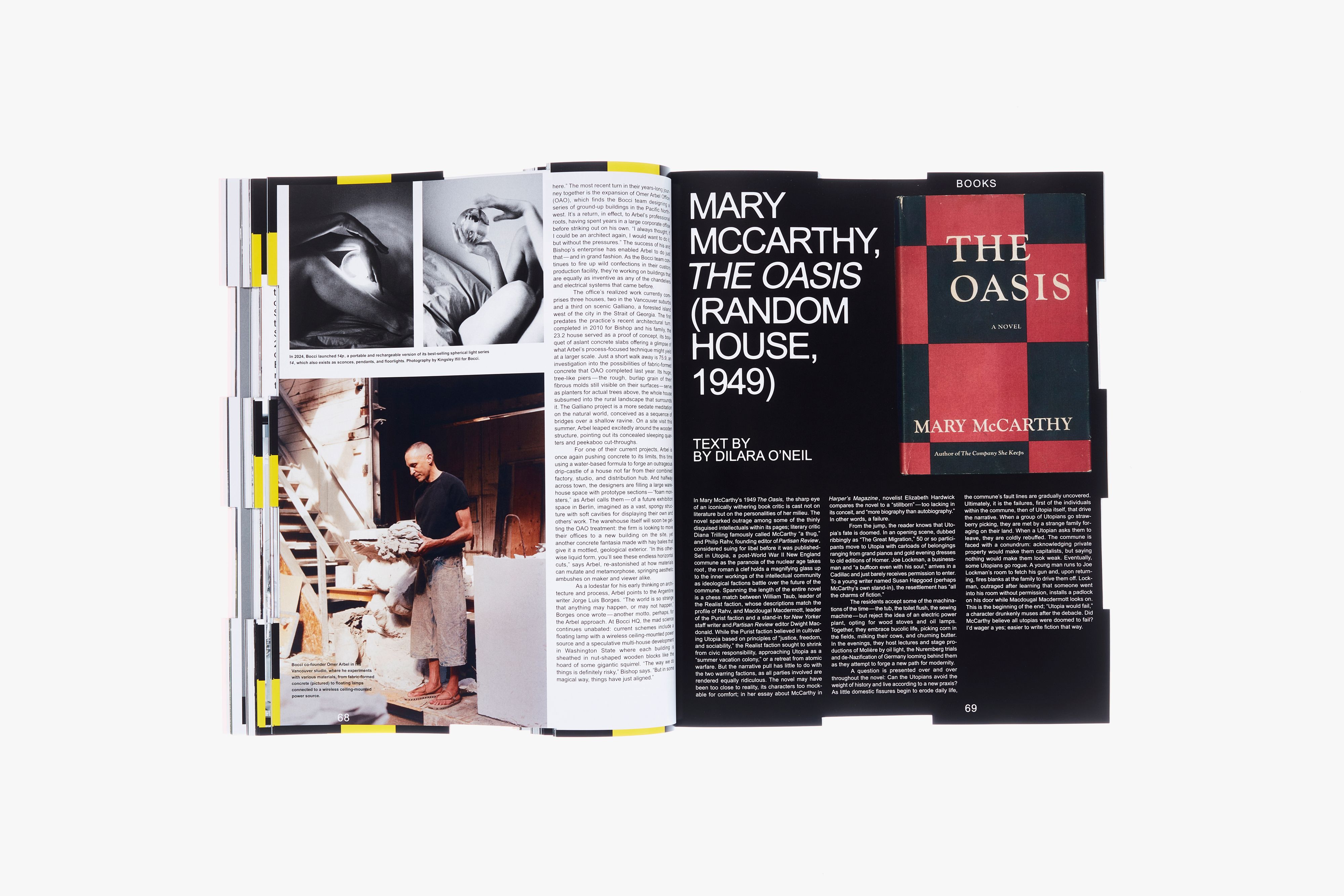SEEKING UTOPIA
Mary McCarthy’s The Oasis
by Dilara O'Neil
Spread photographed by Luke Libera Moore.
In Mary McCarthy’s 1949 The Oasis, the sharp eye of an iconically withering book critic is cast not on literature but on the personalities of her milieu. The novel sparked outrage among some of the thinly disguised intellectuals within its pages; literary critic Diana Trilling famously called McCarthy “a thug,” and Philip Rahv, founding editor of Partisan Review, considered suing for libel before it was published. The roman à clef — set in Utopia, a post–World War II New England commune as the paranoia of the nuclear age takes root — holds a magnifying glass up to the inner workings of the intellectual community as ideological factions battle over the future of the commune. Spanning the length of the entire novel is a chess match between William Taub, leader of the Realist faction, whose descriptions match the profile of Rahv, and Macdougal Macdermott, leader of the Purist faction and a stand-in for The New Yorker staff writer and Partisan Review editor Dwight Macdonald. While the Purist faction believed in cultivating Utopia based on principles of “justice, freedom, and sociability,” the Realist faction sought to shrink from civic responsibility, approaching Utopia as a “summer vacation colony,” or a retreat from atomic warfare. But the narrative pull has little to do with the two warring factions, as all parties involved are rendered equally ridiculous. The novel may have been too close to reality, its characters too mockable for comfort; in her essay about Mary McCarthy in Harper’s Magazine, novelist Elizabeth Hardwick compares the novel to a “stillborn” — too lacking in its conceit, and “more biography than autobiography.” In other words, a failure.
From the jump, the reader knows that Utopia’s fate is doomed. In an opening scene, dubbed ribbingly as “The Great Migration,” 50 or so participants move to Utopia with carloads of belongings ranging from grand pianos and gold evening dresses to old editions of Homer. Joe Lockman, a businessman and “a buffoon even with his soul,” arrives in a Cadillac and just barely receives permission to enter. To a young writer named Susan Hapgood (perhaps McCarthy’s own stand-in), the resettlement has “all the charms of fiction.”
The residents accept some of the machinations of the time — the tub, the toilet flush, the sewing machine — but reject the idea of an electric power plant, opting for wood stoves and oil lamps. Together, they embrace bucolic life, picking corn in the fields, milking their cows, and churning butter. In the evenings, they host lectures and stage productions of Molière by oil light, the Nuremberg trials and de-Nazification of Germany looming behind them as they attempt to forge a new path for modernity.
A question is presented over and over throughout the novel: Can the Utopians avoid the weight of history and live according to a new praxis? As little domestic fissures begin to erode daily life, the commune’s fault lines are gradually uncovered. Ultimately, it is the failures, first of the individuals within the commune, then of Utopia itself, that drive the narrative. When a group of Utopians go strawberry picking, they are met by a strange family foraging on their land. When a Utopian asks them to leave, they are coldly rebuffed. The commune is faced with a conundrum: acknowledging private property would make them capitalists, but saying nothing would make them look weak. Eventually, some Utopians go rogue. A young man runs to Joe Lockman’s room to fetch his gun and, upon returning, fires blanks at the family to drive them off. Lockman, outraged after learning that someone went into his room without permission, installs a padlock on his door while Macdougal Macdermott looks on. This is the beginning of the end; “Utopia would fail,” a character drunkenly muses after the debacle. Did McCarthy believe all utopias were doomed to fail? I’d wager a yes; easier to write fiction that way.